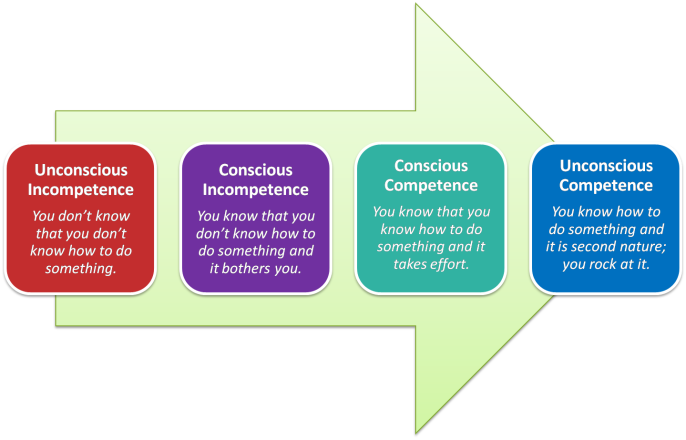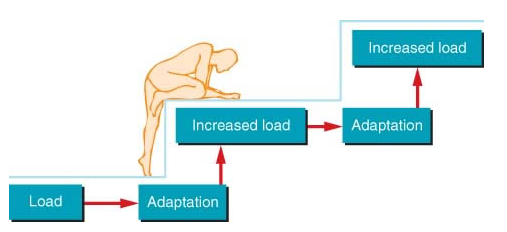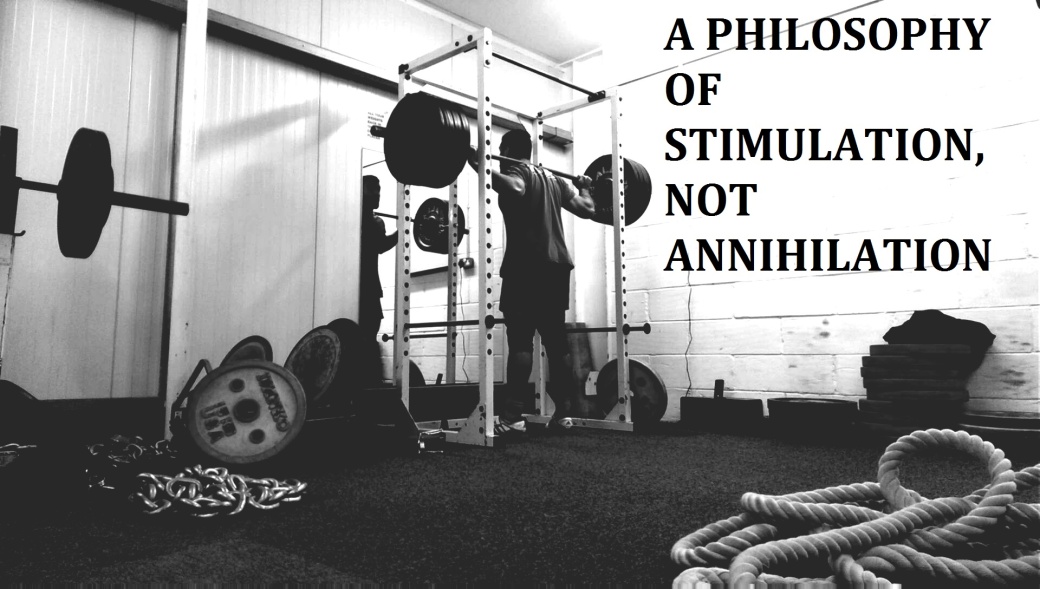As the antiquated saying goes, “training is an art and a science.” Unfortunately when you walk into a modern day gym today you’re more likely to meet Picasso than you are to see picture perfect form, proper technique, and intelligent exercise programming.
The art of training answers the why and is highly individual to each person, but the science, the how, is based on governing principles of biology, adaptation, and physiology.

Understanding these governing principles will maximize your training effect and ensure you’re getting the most out of your time investment in the gym.
(You do want results after all? Right?)
-
Master Movement Patterns
Master the foundational movement patterns because they govern the way you move your body through space. Make progress to build strength using your own body weight. You don’t want to load dysfunction.
A music teacher of mine taught me that it takes 7 times of playing something the right way before you’ve ingrained it in your mind. BUT if you learn it the wrong way it will take 14! It takes longer to undo something you learned the wrong way than it does to learn it right the first time.
You want to develop function and proprioception. Hire a personal trainer, take videos of yourself, watch videos, read about form and strive to achieve unconscious competence.

PRACTICAL GYM APPLICATION:
The most powerful muscle you can use in the gym is your mind. (The mind isn’t really a muscle, although it contains a bit…)
Don’t just count every rep, make every rep count.
-
Progressive Overload
Progressive Overload = the gradual increase of stress placed upon the body during exercise training.

It was developed by Dr. Thomas Delorme. He was an army physician who was working to rehabilitate soldiers after WWII.[i] (Although it’s been used over the centuries.)
“DeLorme had used strength training to recover from a childhood illness and reasoned that such heavy training would prove beneficial for the injured servicemen. DeLorme’s new protocol consisted of multiple sets of resistance exercises in which patients lifted their 10-repetition maximum. DeLorme refined the system by 1948 to include 3 progressively heavier sets of 10 repetitions, and he referred to the program as “Progressive Resistance Exercise.” [… DeLorme’s work] helped legitimize strength training and played a key role in laying the foundation for the science of resistance exercise.” [ii]

PRACTICAL GYM APPLICATION:
Add a little more weight (intensity), a few more reps or sets every workout (volume) and build up over time (progressive overload.) Your training split (frequency) should fit with your lifestyle (recovery/stress) and your exercise selection (sequencing) and rest periods (density) should match your goals: Want to be better at squatting? You need to squat (specificity.)
Manipulating the above training variables and techniques (Although there many are more… Remember exercise is an art and a science.) will take you far in maximizing your true genetic potential!
Be consistent and chase performance.
-
SAID Principle
The SAID Principle (Specific Adaptation to Imposed Demands) states that our body adapts to the demands we impose upon it. This principle is foundational to the training and detraining that every human being is practicing. You are always adapting to something, whether it’s chasing peak physicality, maintaining or declining.
The old adage: “Use it or lose it,” comes to mind. You can see this idiom in practice in the life of Ralph Freeman, who is a veteran of WWII and Korea and turned 100 years old on June 14 of this year! He credits his positive attitude and lifting weights as keys to his longevity.[iii]

PRACTICAL GYM APPLICATION:
Love your body. It’s doing many amazing physiological processes to keep you alive, from a cellular, metabolic and anatomic level. Nutrition and activity have a synergistic effect on these things.
NEVER accept your body. If you accept your body the way it is you welcome a life of weakness, immobility, declining quality of life, and possible early mortality.
Defy Gravity and let Ralph’s story inspire you to keep nurturing your strong body, sharp mind, active lifestyle and healthy relationships.
-
Goal Setting
As you can see from Ralph Freeman’s incredible life, the man has GOALS, a plan to execute them and does them daily! Likewise, you too should have training goals and the type of training should reflect the results you seek. When you walk into a gym you should have a plan of action and thoroughly disrupt homeostasis. When you leave you should know that there was a training effect that took place. It doesn’t have to be soul crushing every time, but it shouldn’t be a walk in the park either… (unless that is your chosen activity for the day!) Lee Haney, 8 time Mr. Olympia and bodybuilding champion, said it best…Stimulate, Don’t Annihilate!

So What Are Your Goals?
Ask any regular gym goer about their goals and you might hear a response like,
“Get in shape, lose fat, build muscle and strength.”
You’ll nod and agree. It sounds like a pretty good plan. And it is as long as you understand the nuances… each one of those things is actually a different goal that will require a different plan of action.
THREE PRIMARY GOALS THAT PEOPLE HAVE:
- Fat loss– by far the most popular goal people have.
Nutrition is the biggest limiting factor in having a jaw-dropping transformation. At some point you’ll need to maintain your weight loss for a period of time (usually after a 10% total loss) or pick another goal before pursuing more fat loss. This is called nutritional periodization. A recent study showed that dieters who alternated between maintenance calories and reduced calories ended up losing more weight in the end, keeping it off longer, and their metabolisms weren’t as depressed as the group who ate less![iv]
(Read about The MATADOR (Minimising Adaptive Thermogenesis And Deactivating Obesity Rebound) study HERE and Contact Us If you’d like a more detailed laymen overview of what the study showed.)
People pursue fat loss ALONE to a detriment. How many times have you heard this?
“I just want to lose those last X amount of pounds.”
Below is a picture of a Amelia’s transformation.
These pictures were taken THREE YEARS APART.
DON’T scroll down too quick, just look at the pictures first and guess what you think the weight difference is?

That’s right she is TEN pounds heavier in the second picture. She’s lost fat, increased performance and successfully built muscle and achieved body recomposition.
The crazy part is that if people’s rhetoric was, “I just want to gain those last 10 pounds of muscle.” They’d likely achieve all their other goals. Speaking of muscle building…
- Hypertrophy– this is a fancy word for building muscle.
This goal takes a calorie surplus, adequate protein and recovery paired with a progressive resistance training program. You can’t always do the same thing over and over again and expect to change. Your body will just get really good at doing that one workout.
- Strength– this goal could be to feel stronger for overall daily activity, get stronger in certain lifts or for a specific sport.
There is some overlap that exists but when choosing it’s best to have ONE primary goal at a time, and that will determine what your exercise routine and good nutrition plan look like.
There are many variables that proper training programming takes into consideration such as: Goals, Frequency, Training Split, Intensity, Volume, Rest, Density, Exercise Selection (you’ll want to select some compound and isolation exercises based off of these foundations) Form, Technique, and much more.
PRACTICAL GYM APPLICATION:
Periodization- set specific goals for specific amounts of time or until you reach them.
Understand realistic progress- setting up unrealistic expectations will rob you from the joy of the journey[v]. If you only care about the destination you’ll never arrive.
Celebrate the small steps- Small steps in the right direction will lead you to your desired outcomes.
~Practice Daily Habits~
~Consistency is King~
~Progress Over Perfection~
~No Failure Only Feedback~
We cannot control the outcomes we desire, but we can control the behaviors that will lead us to our goals. That is why I believe in the power of habit-based coaching.
“Keep the Goal the Goal.” ~Coach Dan John
If you would like a custom progressive exercise program designed for your specific needs, level and goals, a nutritional triage assessment, and coaching to transform your body, health, and outlook, let’s connect.
[i] Kraemer, William J.; Fleck, Steven J. (2007). “Progressive Overload”. Optimizing Strength Training: Designing Nonlinear Periodization Workouts. Human Kinetics. pp. 33–6.
[ii] J Strength Cond Res. 2012 Nov;26(11):2913-23. doi: 10.1519/JSC.0b013e31825adcb4.
[iii] http://www.latimes.com/socal/daily-pilot/entertainment/tn-wknd-et-ralph-freeman-20171103-story.html
[iv] https://www.nature.com/articles/ijo2017206
[v] Foster, G. D., Wadden, T. A., Vogt, R. A., & Brewer, G. (1997). What is a reasonable weight loss? Patients’ expectations and evaluations of obesity treatment outcomes. Journal of Consulting and Clinical Psychology, 65(1), 79-85. http://dx.doi.org/10.1037/0022-006X.65.1.79


2 thoughts on “FOUR KEY PRINCIPLES FOR MAXIMIZING YOUR GYM TIME AND RESULTS”